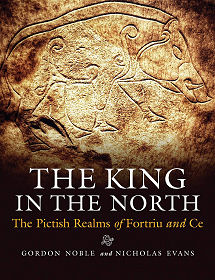 |
Perhaps the first thought that struck us when we saw "The King in the North: The Pictish Realms of Fortriu and Ce" by Gordon Noble and Nicholas Evans was what a remarkably resonant title it had. The book was published on 23 May 2019, just a few days after the broadcast of possibly the most anticipated TV show in history, the final episode of the final series of "Game of Thrones". For that reason its title is guaranteed to catch the eye on the bookshop shelf: "The King in the North" of course being one of the ancient titles held by House Stark of Winterfell.
While the immediacy of that resonance will inevitably diminish over time, the value of this excellent book is much less likely to. The Picts have long held a fascination for us, and, we suspect, for many others with an interest in the history of what we now call Scotland. In many ways this fascination derives from the aura of mystery that surrounds the Picts. The name we use for them seems to have come from a pejorative expression used by the Romans to describe "painted or tattooed people" and they can be thought of as a a confederation of tribes who lived in what is today eastern and northern Scotland during the Late Iron Age and Early Medieval periods. Their origins are the subject of debate, as is the nature of the process by which their identity was eventually subsumed into that of the Scots. Perhaps what feeds the imagination most is that the main evidence of their existence comes from the metalwork they left and - especially - the magnificent carved Pictish symbol stones with which they dotted the landscape. You don't need to encounter many of these amazing objects to fall under the spell of their creators.
Over the past couple of decades, academic research has transformed our understanding of the Picts; and in particular has seen increasing evidence emerging that their presence in Moray and Aberdeenshire north of the Grampians was much more central and pivotal to their overall story than had previously been thought. Perhaps the most significant single change is the emerging understanding that the focus of the dominant Pictish kingdom of Fortriu lay not, as previously believed, in Perthshire, but instead around the Moray Firth.
This book is written by academics who have been involved in this revolution in our understanding of the Picts and is intended to make the fruits of recent academic research available to a general audience. The result is a fascinating book and one which will have a lasting value. It gives its readers plenty to get stuck into in terms of content, nicely leavened by helpful and often highly enlightening illustrations. The book begins with an introduction to the academic research of the last couple of decades before taking a general view of the northern Picts. It then moves into a series of thematic chapters, looking at fortified settlements in northern Pictland; at the significance of Rhynie; at monumental cemeteries; at the Gaulcross hoard; at the development of the Pictish symbol system; and at the early Church in northern Pictland. It ends with a coda, a conclusion if you prefer; and with information about sites to visit.
There have been many books written about the Picts. Perhaps the most significant thing about this one is that it fundamentally changes the background picture that will be presented by the the others that will doubtless follow on the subject.
InformationPaperback: 208 pagesBirlinn Ltd birlinn.co.uk 23 May 2019 Language: English ISBN-10: 178027551X ISBN-13: 978-1780275512 Size: 19 x 24.5 cm Buy from Amazon (paid link) Visit Bookshop Main Page |
